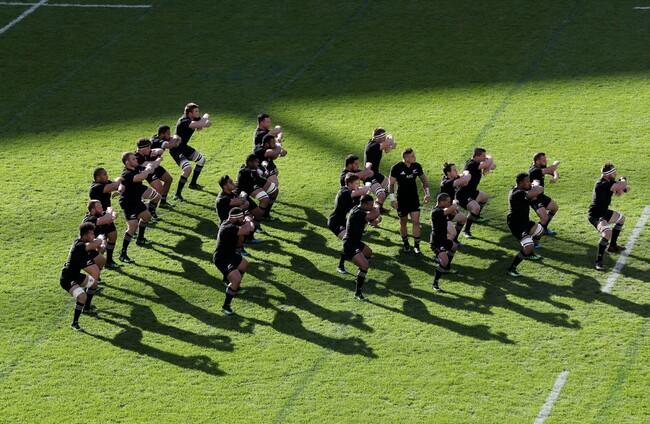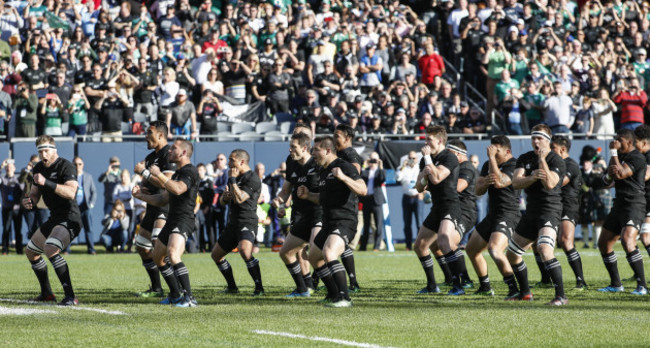THE HAKA RITUAL has become one of the most celebrated characteristics of the All Blacks. It’s believed to be a generic term for all Maori dance and outside of the realm of sport, the haka is performed at a range of events including weddings, family occasions and other significant celebrations.
The different variations allow the performers to demonstrate their national pride by acting out different gestures while chanting the lyrics in their native tongue.
When it comes to the All Blacks haka, you’ll see one player from the team stepping forward to announce the beginning of the dance with a loud battle cry. They then move through the group and conduct the movements. Scrum-half Aaron Smith has often executed this role while All Blacks legend Tana Umaga directed the haka in earlier years.
After Ireland’s historic win over the All Blacks in Chicago, former New Zealand prop Craig Dowd accused his national side of acting out a ‘disrespectful’ haka. The version he was referring to was the Kapa O Pango, which he categorised as a more “aggressive” form of haka, and therefore not the right choice, given the recent death of Anthony Foley.
The second encounter between Ireland and New Zealand takes place tomorrow and the haka selection for that fixture remains a mystery. In the meantime, here’s a run down of some of the existing hakas out there.
Ka Mate
This haka dance stretches back to the early 1800s and refers to a time of war and tribal conflict. It’s the original haka pre-match ritual that the rest of the world has been exposed to and has been associated with New Zealand rugby since as early as 1888.
The original All Blacks began using it in 1905 and it was normally restricted to games outside the country until the 1980s when Wayne “Buck” Shelford and Hika Reid requested that the dance be performed before home games as well.
This form of haka is often seen at funeral ceremonies, which is why Craig Dowd argues that it would have been the more fitting selection for the first Test against Ireland.
The lyrics and gestures of the chant are:
Ringa pakia
(Slap the hands against the thighs)
Uma tiraha
(Puff out the chest)
Turi whatia
(Bend the knees)
Hope whai ake
(Let the hip follow)
Waewae takahia kia kino
(Stamp the feet as hard as you can)
Ka mate! Ka mate!
(It is death!, It is death!)
Ka ora! Ka ora!
(It is life!, It is life!)
Ka mate! Ka mate!
(It is death! It is death!)
Ka ora! Ka ora!
(It is life! It is life!)
Tenei Te Tangata Puhuru huru
(This is the hairy man)
Nana nei tiki mai
(Who fetched the sun)
Whakawhiti te ra
(And caused to shine again)
A upa ne ka up ane
(One upward step, another upward step)
Upane, Kaupane
(An upward step)
Whiti te ra
(The sun shines!)
Kapa O Pango – ‘Team In Black’
This dance was first performed by the All Blacks in 2005 before a Tri Nations Test match against South Africa and was led by Tana Umaga. It was created by Derek Lardelii, an expert in Maori culture, and took one year to construct.
Lardelli says that it’s a ceremonial piece rather than a war dance, designed to build a person’s confidence, which explains why a rugby team would use it to prepare themselves for a game.
It was invented to complement the Ka Mate haka as a means of celebrating their home land and its culture. Explaining what the Kapa O Pango means to the All Blacks, former player Aaron Mauger said:
“It’s full of pride. For modern All Blacks, it’s about the time in the jersey and the silver fern and the blackness in the jersey. It’s certainly not there to replace Ka Mate, it’s there as a brother alongside it so we’re still pretty proud of Ka Mate and we use them as passionately as each other.”
The translated lyrics are:
Let me go back to my first gasp of breath
Let my life force return to the earth
It is New Zealand that thunders now
And it is my time!
It is my moment!
The passion ignites!
This defines us as the All Blacks
And it is my time!
It is my moment!
The anticipation explodes!
Feel the power
Our dominance rises
Our supremacy emerges
To be placed on high
Silver fern!
All Blacks!
Silver fern!
All Blacks!
aue hi!
Poropeihana - The haka of Wesley College
This dance was performed by former and current students of Wesley College, as a mark of respect during the funeral of Jonah Lomu last year. Situated in Auckland, Wesley College boasts a proud rugby tradition, producing talents such as Stephen Donald and Charles Piutau as well as Lomu.
The former students who attended the college along with Lomu completed their version first, followed by a rendition of Ka Mate by Lomu’s former All Blacks teammates with some of the current Wesley College students performing their haka after. Lomu’s family then released 40 doves into the sky as a symbol of peace.
Other styles of haka include the Peruperu, which is a traditional war dance incorporating the use of weapons while the Tutu Ngarahu prefaces a battle and features side-to-side jumping. The Manawa wera haka is commonly associated with funerals where the dancers are free to dance expressively with no particular routine involved.
The42 is on Instagram! Tap the button below on your phone to follow us!


